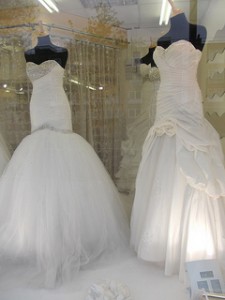Paying More for the White Dress
In an article for The New York Times Magazine, Catherine Rampell explores the “wedding markup.” While planning her own wedding, Rampell was surprised by the lack of transparency in the wedding industry, even with all the wedding-related sites on the Internet:
Wedding vendors seemed to be trying to size me up to figure out how much I’m willing to pay; consumer advocates say this is a common practice, as is charging more for a given service for a wedding than for a “family function” or “corporate event.” Austan Goolsbee, an economics professor at the University of Chicago Booth School of Business, recalls that when he was married over a decade ago, one caterer initially quoted him about $60 a head, and then jacked up the price to about $90 per person after realizing the function was a wedding. These are forms of what economists call price discrimination; it sounds unfair, but it’s perfectly legal, and it’s easier to get away with in markets where there’s little price transparency and consumers are relatively uninformed.
Many of the industry experts Rampell interviewed attributed the markup to the fact that brides are usually less-informed “first-time shoppers,” and also to the “once-in-a-lifetime logic”:
Because this event is (ideally) once in a lifetime, that also means that vendors can appeal to consumers’ sentimentality, urging them not to cheap out on the “most important” day of their lives. Because of similar concerns about guilt-tripping salespeople, the Federal Trade Commission requires funeral homes to provide its bereaved customers with an itemized price list.
Many in the wedding industry wielded this once-in-a-lifetime logic, explaining to me that wedding services are not standardized enough to create a meaningful price aggregator. With books, there’s a single bar code for each product, but it’s hard to do apples-to-apples pricing comparisons between wedding bands or photographers. This argument isn’t incredibly compelling. After all, I can see prices for highly differentiated food-delivery options on sites like Seamless. Locality, a start-up, has been collecting and publishing a menu of prices for services usually considered highly nonstandardized, like massages, day care and dentist visits. Creating something similar for wedding services should not be insurmountably difficult.
Ultimately, Rampell concludes that consumers with strong preferences — the dreaded “Bridezillas” — make the industry particularly resistant to transparency and fair prices. “[I]f there are enough brides out there with strong and specific preferences, who want their weddings to be the special day they always dreamed of, that’s going to push equilibrium prices higher, no matter how transparently they are displayed,” she writes. “In other words, the Bridezillas keep prices high for the rest of us.”


Comments